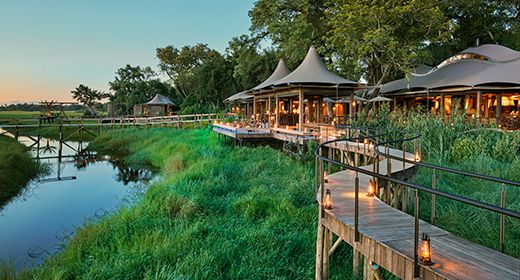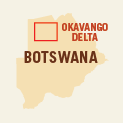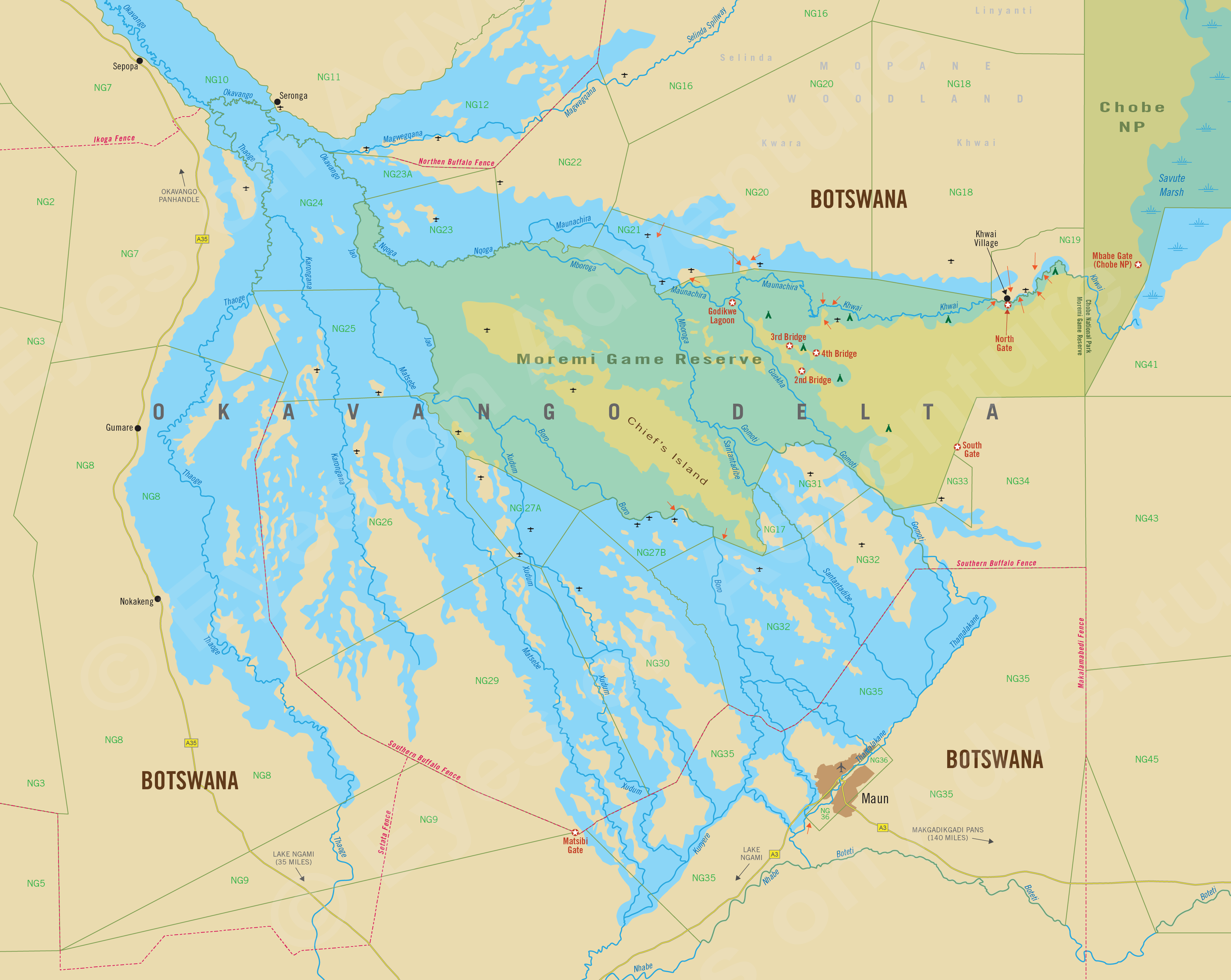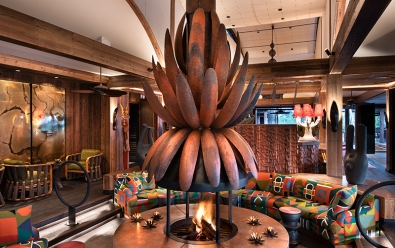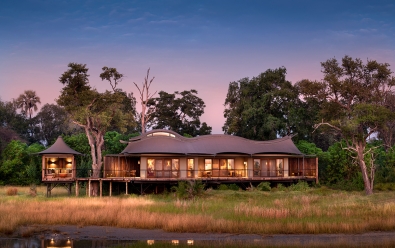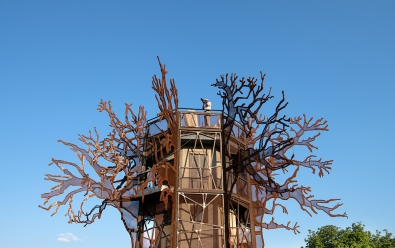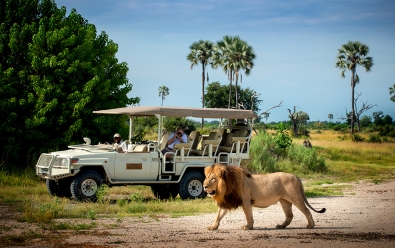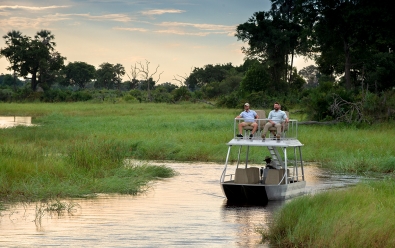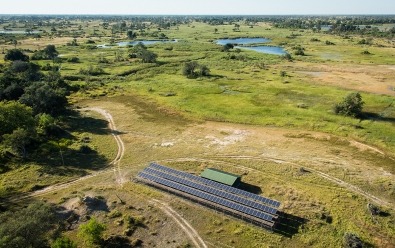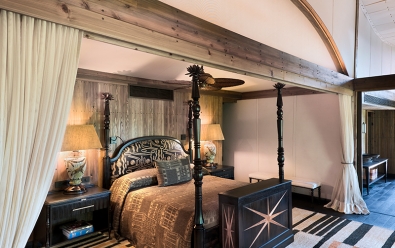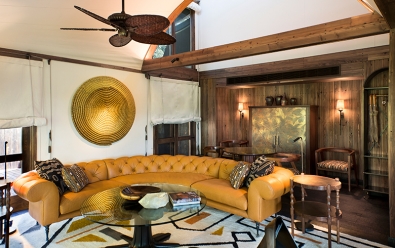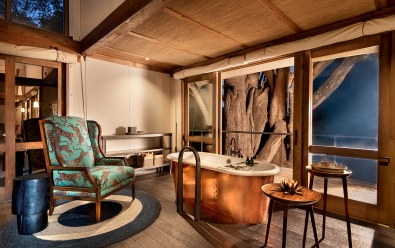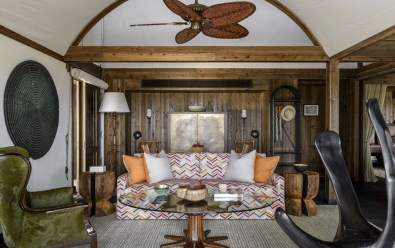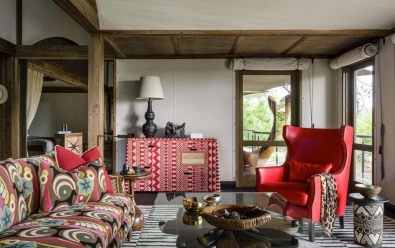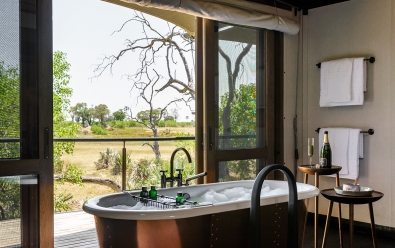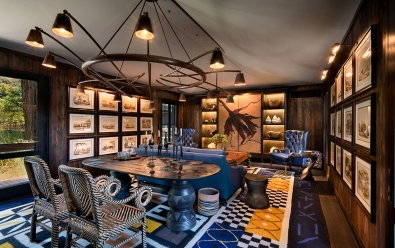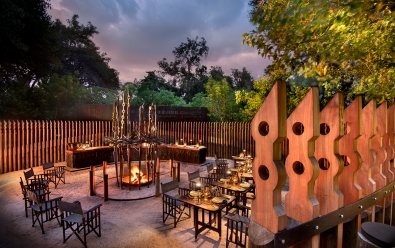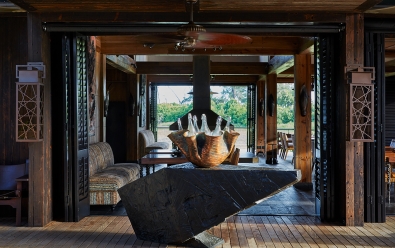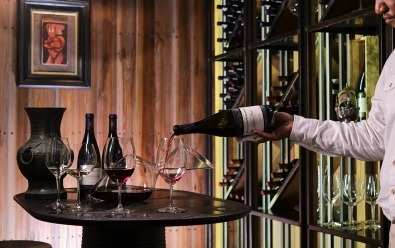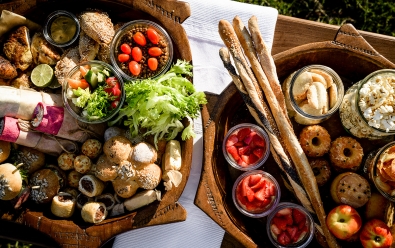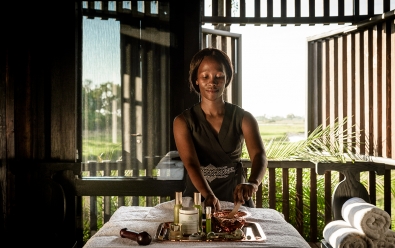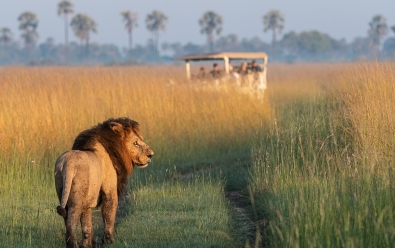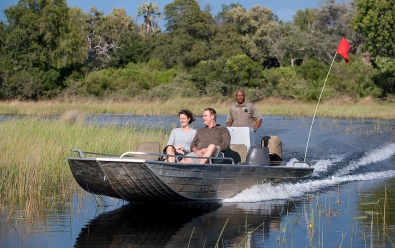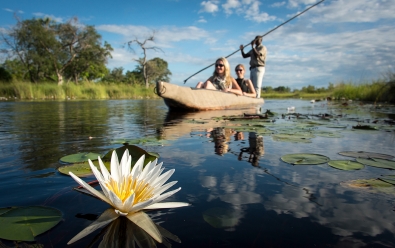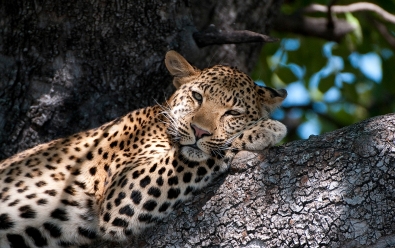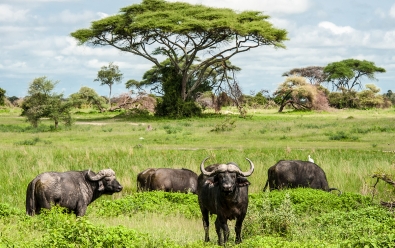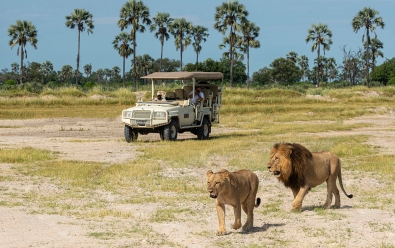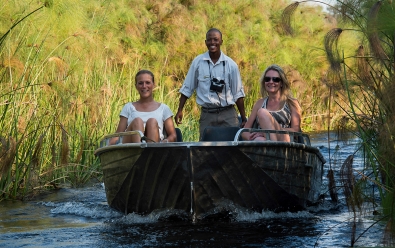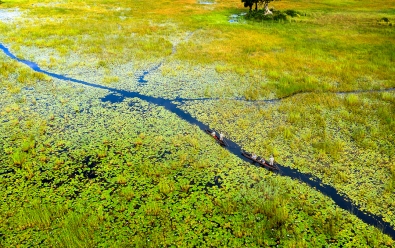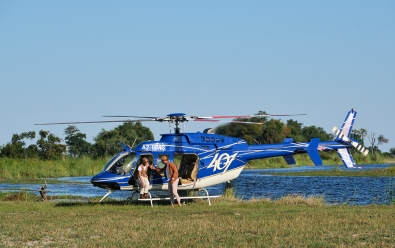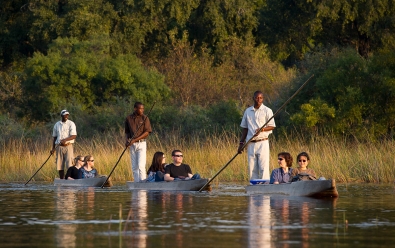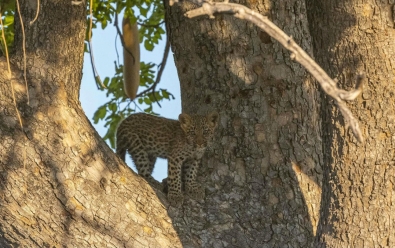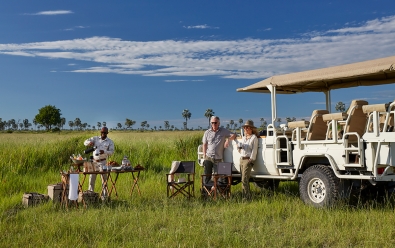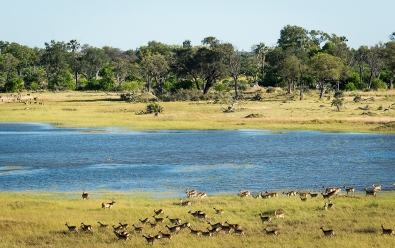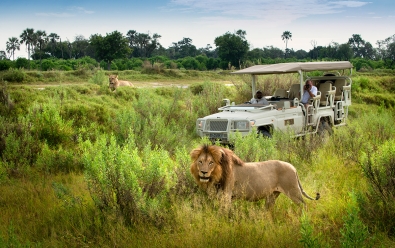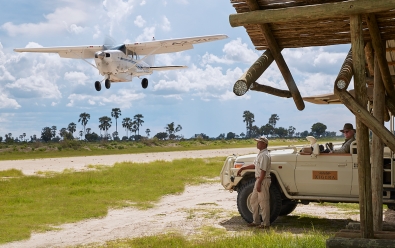Xigera Safari Lodge
Inquire for lodging prices
Highlights
- One of the most luxurious safari lodges in Africa
- Located in the wildlife-rich Moremi Game Reserve
- Offers diverse activities on land and water
- Eco-friendly lodge operates primarily on solar power
Location
- Moremi Game Reserve / Paradise Island
- Okavango Delta
- Northern Botswana
Xigera Safari Lodge is situated on the edge of Paradise Island within the Moremi Game Reserve, the core protected area of Botswana's prime wildlife destination, the Okavango Delta.
The previous camp located on the site was completely removed and replaced with one of the Okavango's most luxurious lodges by the renowned Red Carnation Hotels. The lodge is designed with every creature comfort imaginable, including full air-conditioning in the spacious guest suites.
The lodge and suites are constructed of flame-torched timber, with wide views of the lily-filled lagoons and palm-fringed floodplains. The 'new' Xigera opened for guests in December 2020.
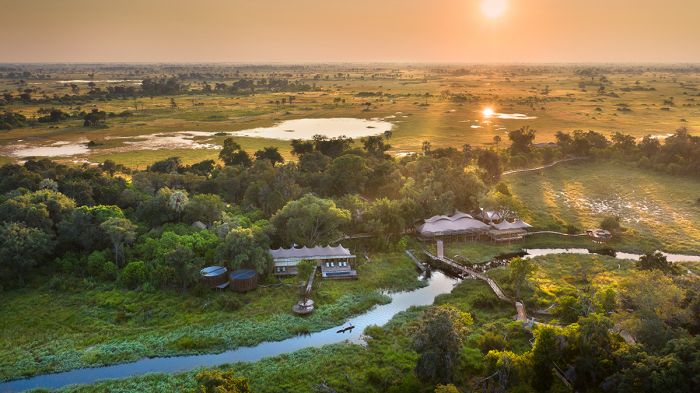
Sunrise and early morning mokoro outing leaving Xigera Safari Lodge.
The interiors of the lodge and guest suites are replete with exceptional artworks, created by well-known African artisans, including hand-forged copper and steel consoles, original mixed-media wall coverings, and the astounding three-story high steel baobab sculpture that doubles as a sleep-out location under the stars.
Of course, the service and cuisine are top-notch at Xigera and nothing is spared by the staff when it comes to giving guests a once-in-a-lifetime experience.
Xigera offers 12 spacious, fully air-conditioned guest suites, one of which is a double/family suite that can accommodate 4 persons. The large suites include a bedroom and dressing area, a separate lounge, and an expansive outdoor deck with a gazebo.
The habitat at Xigera in this far western side of the Moremi Game Reserve is a wetland paradise, with permanent waterways, palm-dotted islands, large areas of papyrus swamp, seasonal floodplains, open grassland savanna, and open woodland.
Wildlife species commonly seen at Xigera includes elephant, red lechwe, buffalo, tsessebe, reedbuck, bushbuck, impala, waterbuck, zebra, blue wildebeest, giraffe, warthog, and hippo. Common predators include lion, spotted hyena, leopard, and crocodile. There is also a very good chance to see the elusive sitatunga, a water-dwelling antelope.
Xigera offers year-round safari drives, but the surrounding habitat, which is dominated by Okavango water, means that the focus is on water-based activities, exploring by motorized boat and mokoro (traditional dugout canoe).
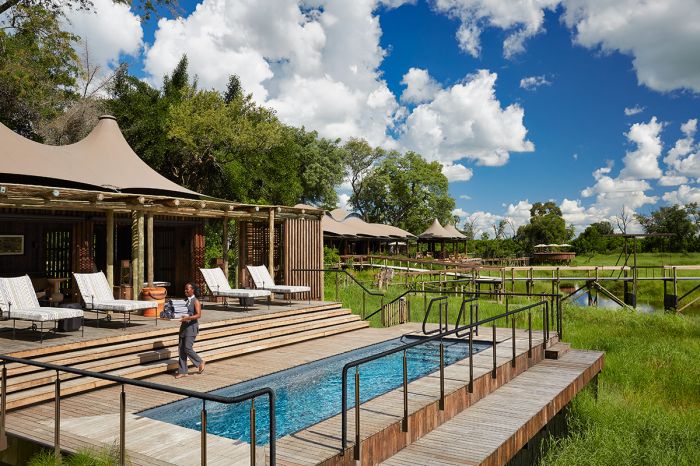
Pool deck.
During the peak months of the Okavango floods (typically June to August), guests can travel by motorized boat across the floodplains and along seasonal channels to reach other islands to see more wildlife. Birding at Xigera is very good all year, particularly for water birds.
Xigera Safari Lodge is powered by a hybrid system, which combines solar power and a diesel-powered generator. The high-tech system of solar panels and inverters provide electricity to the camp for most of the day and the generator only needs to operate as a back-up. Strict eco-friendly environmental standards are maintained so that no harmful chemicals or waste is allowed to enter the pristine ecosystem of the Okavango Delta.
Xigera is dedicated to safeguarding the Okavango ecosystem, while empowering the local community and striving for environmentally conscious hospitality and sustainable conservation. The camp works together with the TreadRight Foundation (treadright.org) to ensure that the precious wildlife surrounding Xigera is permitted to thrive.
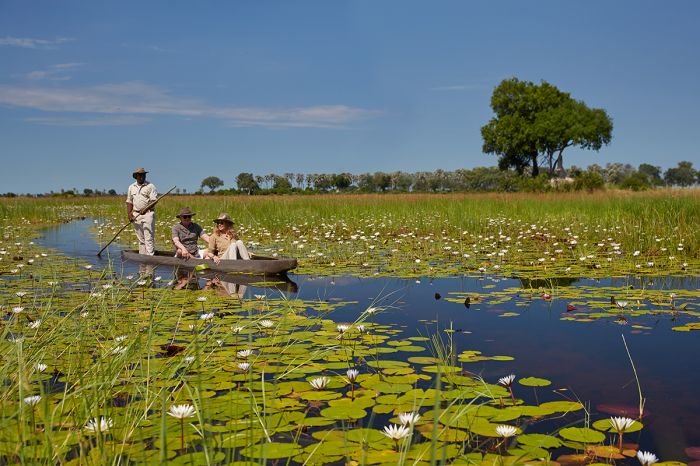
Mokoro activity at Xigera.
About the Okavango Delta
The Okavango Delta is one of Africa's greatest safari destinations and offers an incredible diversity and abundance of wildlife. The Okavango is an UNESCO World Heritage Site as well as a Ramsar Wetland of International Importance.
Often referred to simply as "the Delta", the Okavango is characterized by an ever-changing network of waterways that originate far to the northwest in the highlands of Angola. The Cubango River flows into northern Botswana and spills into the flat expanse of Kalahari sands, where it fans out into a shallow trough formed by tectonic faults beneath the sand.
The annual 'flooding' of the Okavango brings in rich sediments that provide nutrients atop the sands, which in turn creates a diverse ecosystem of permanent and seasonal waterways, deep-water lagoons, papyrus beds, palm-covered islands, seasonally flooded grasslands, and woodlands. The rich fresh-water environment changes year-to-year depending on the level of the floodwaters making it one of the most dynamic wildlife destinations on Earth.
Wildlife in the Okavango Delta is diverse and includes all of Africa's Big Five animals (lion, leopard, elephant, rhino, and buffalo. Commonly seen herbivores include giraffe, plains (Burchell's) zebra, blue wildebeest, impala, tsessebe, common reedbuck, greater kudu, waterbuck, buffalo, elephant, and warthog. Both species of rhino are found, albeit in small numbers. The Delta is also home to red lechwe and sitatunga, both of which are water-dependent antelopes.
The abundance of herbivores means that predators are common in the Okavango. Commonly seen species include lion, leopard, spotted hyena, black-backed jackal, and African wild dog. Cheetah are sometimes seen in the larger grasslands like those on Chief's Island. Less frequently encountered predators include serval, caracal, honey badger, and various species of mongoose.
The abundance of water in the Okavango provides habitat for Nile crocodiles and hippos, both of which are seen easily at any of the safari camps located near the Delta's permanent water. Primates in the Delta include chacma baboon, vervet monkey, and bush baby (galago).
Birding is outstanding in the Delta, with over 400 species possible. A typical safari day can easily produce over 100 species for an avid birder.
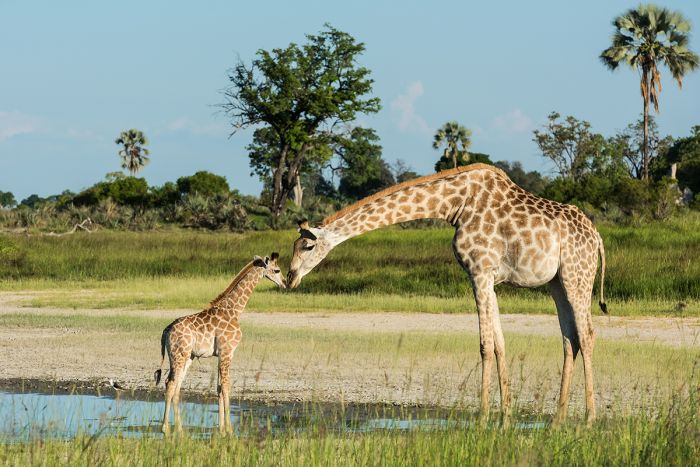
Giraffe and her baby near Xigera Safari Lodge.
Moremi Game Reserve
Forming the core protected area in the central and eastern portion of the Okavango Delta, the Moremi Game Reserve was created in 1963 and named for Chief Moremi III of the local Batawana people.
Moremi covers roughly one-third of the Okavango and includes some of the Delta's prime wildlife habitats, including Chief's Island, the largest land mass in the Okavango.
ROOMS INCLUDES & EXCLUDES CHILDREN FACILITIES ACTIVITIES
Accommodation
12 luxurious, fully air-conditioned guest accommodations in total comprising:
- 11 standard suites: 9 have king-size beds and 2 have twin beds (can be converted into king-size beds using mattress converters).
- The Xigera Family Suite, comprising two full bedrooms (one of which has a fixed king-size bed while the other has twin beds which can be converted into a king-size bed using a mattress converter). Each bedroom includes its own full bathroom, dressing area, outdoor shower, and all the offerings found in a normal suite, joined by an inter-leading lounge area that opens up onto a deck with a gazebo.
Each guest suite has 1 980 sq feet (184 sq meters) of indoor and outdoor space, including a separate lounge, bedroom, and dressing room area.
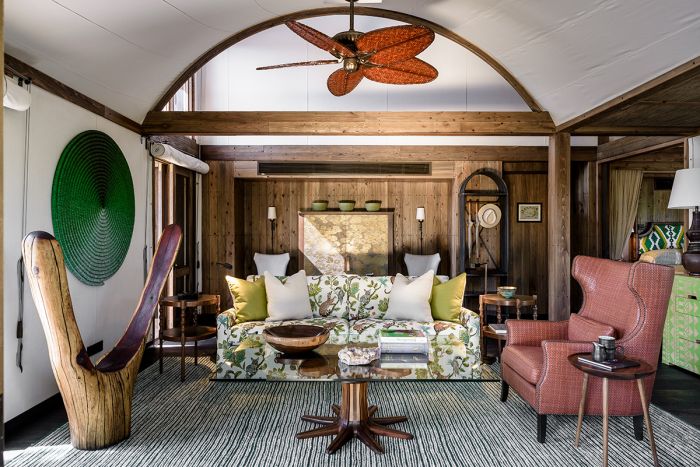
Guest suite lounge with bedroom to the rear/right.
Each suite has full en-suite facilities with separate toilet, shower, bath, outdoor shower, separate lounge, bedroom, and dressing room area. and
Other items and features in the guest suites include:
- Mosquito netting for the beds.
- Coffee and tea making facilities.
- Mini bar.
- Private deck with outdoor gazebo.
- Stretched canvas tented roofs.
- Wooden decks reached by elevated wooden walkways.
- Tinted glass windows to keep the room at even temperatures (can be opened to allow the breeze and birdsong to enter).
- Full air-conditioning.
- In-tent TV.
- In-tent Wi-Fi.
- Ecologically sensitive amenities, and all creature comforts.
Xigera Camp can accommodate a maximum of 26 guests in total: two adults + two children in the Family Suite and 2 persons in each of the 11 standard suites.
Includes & Excludes
Includes:
- All meals and local beverages including wines, spirits and liqueurs, but excluding premium imported brands and Champagne.
- Twice-daily safari drives in open game-viewing vehicles, water-based activities, walking, scheduled yoga classes, and other scheduled camp activities (accompanied by experienced guides).
- Laundry services are provided on a daily basis (weather permitting, items will be returned on the same day). Laundry is dried by the sun and on most days any laundry placed out in the morning will be returned by the evening.
- Wi-Fi access.
- Tourism Levy & VAT.
Excludes:
- Purchases from the Xigera Shop.
- Premium imported beverages and Champagne.
- Spa treatments.
- Private yoga classes.
- Baobab Treehouse Sleep-outs.
- Scenic helicopter flights ranging in duration from 30, 45 to 60 minutes - with a minimum of 2 guests and a maximum of 5 or 6 depending on the helicopter used (morning or afternoon).
- Any applicable wildlife fee, park fee, reserve fee, concession fee, other land-use fee.
Single Supplement
A single supplement will apply for any room booked by a single traveler; please ask us for pricing.
Children
Children aged 12 years and older are accommodated at Xigera Safari Lodge:
- Children between 12 and 16 years must share with an adult/s in the same suite.
- The minimum age for mokoro activities is 13 years (water levels permitting).
- The minimum age for walking is 13 years.
Facilities
Xigera Safari Lodge is nestled beneath a mature canopy of mangosteen, leadwood, and jackalberry (ebony) trees. All 12 air-conditioned suites have been carefully situated to give wide views of the floodplain to allow guests to watch passing wildlife from their private suite and deck.
The camp is situated on a large island, surrounded by deep channels and lush vegetation and the suites and main area are arranged to allow superb views of the Xigera channel.
Notable features of the camp include:
- Lounge and dining room with open fireplace.
- African-inspired cuisine.
- Bar and wine cellar.
- Air-conditioned library.
- Traditional boma and outdoor fire-pit.
- Star deck.
- Swimming pool.
- Well-equipped gym and Wellness Centre.
- Spa.
- African art.
Activities
Activities included in the rate:
- Daytime safari drives in 4x 4-seater and 2x 6-seater open 4x4 Land Cruisers.
- During winter months, hot water bottles (on early morning game drives only), blankets, and lined ponchos are provided.
- Water-based activities in 2-seater glass-bottom mekoros and 4x 06-seater motorized boats, 2 of which have a super-structure with roof seating available (water levels permitting).
- Fishing on a catch-and-release basis year round (except January and February when fishing is barred by law for breeding). This requires a moderate-length boat ride to travel outside the Moremi Game Reserve, which prohibits any fishing.
- Guided nature walks with an expert guide. This requires a moderate-length boat ride to travel outside the Moremi Game Reserve, which prohibits any walking.
- Birding.
- Scheduled yoga classes.
Optional activities at additional cost:
- Private activities are on offer (subject to vehicle availability, which needs to be booked in advance).
- Private yoga sessions.
- One-night Baobab Treehouse Sleepout for 2 adults (subject to availability and weather permitting).
- Scenic helicopter flights ranging in duration from 30, 45 to 60 minutes - with a minimum of 2 guests and a maximum of 5 or 6 depending on the helicopter used (morning or afternoon).
Example of a typical day:
- Early morning wake-up call. Morning wake-up and activity times vary according to the seasons, activities on offer, and wildlife sightings.
- Light breakfast before departing on the morning activity.
- Return to camp for a meal and rest period.
- Meet for afternoon tea and snacks (savory and sweet choices) before departing on the activity.
- Return to camp - freshen up or meet for drinks, followed by dinner.
- Enjoy a nightcap or discussion around the fire before retiring.
Great Good Fair Poor
- Jan
- Feb
- Mar
- Apr
- May
- Jun
- Jul
- Aug
- Sep
- Oct
- Nov
- Dec
WHEN TO GO
The Okavango Delta offers very good wildlife viewing opportunities all throughout the year, but there are seasonal variations in terms of weather that may be a consideration when planning your visit.
The high season in terms of tourist demand is during the dry months between June and October. The latter part of the rainy season is the low season.
The winter (June through August) is dry and cool and wildlife may be easier to find as rain water is evaporating and the rivers and deeper waterholes become more frequently visited by the animals.
During the middle and later stages of the rainy season, the grass becomes tall and the bush becomes lush and thick, which makes for lovely colors, but makes spotting wildlife more difficult.
Xigera Camp is open year-round.
Summer / Rains
Northern Botswana, including the Okavango Delta receives most of its rain between December thru February, which is the summer season. November and December are wonderful months to visit the Delta, with only occasional rainstorms and most rain coming in short showers, which bring relief to the thirsty land after the dry season.
January and February typically experience afternoon downpours on most days, but all-day rain is very uncommon. By the middle of March, the rains become much less frequent and the grass and bush have grown long and thick. Mornings become cooler by the end of March.
In spite of being summer, the rains keep temperatures from becoming overly hot, although humidity and insect life are at their peak. Days are mostly overcast or partially cloudy, with dramatic skies and a lovely green color to the landscape. Afternoon temperatures average 88°F (31°C), but mornings are very comfortable at around 65°F (19°C).
Baby animals are in abundance, especially impala lambs and warthog piglets. Migratory birds arrive to breed and dramatically increase the number of species and overall numbers, particularly in the lagoons and pans, which are full of rain water and food for the aquatic species.
Unlike the dry months (May through October), when the middays can be very warm, causing wildlife to minimize activity and seek shade from around 10am til mid-afternoon, the overcast skies in the summer often mean that animals are active throughout the day, offering many more hours of game viewing.
Autumn
March, April and May are Fall season months and the beginning of the dry season in the Okavango, with rains very uncommon from around mid-March. The landscape is still lush and green, with sunny days and comfortable temps; afternoons average 84°F (29°C). Mornings are comfortable, but a fleece and base layer may be needed for the first hours on game drive.
Migrant birds fly north and water in the lagoons and rain pans is drying up. Permanent waterways in the Delta are however rising, as the 'flood' water from the Angolan highlands is now reaching the Delta.
Morning temps are around 54°F/12°C and afternoons average 79°F/26°C.
Winter / Dry Season
June through August is winter and the vegetation is drying and going dormant. The Okavango flood water is peaking but the surrounding landscape is mostly brown and yellow. Dust and sand particles in the air is on the rise. Game viewing is superb, with elephant and buffalo herds congregating along permanent water.
Mornings can be chilly to very cold at around 45°F (7°C). Warm clothes, including winter hat and gloves are needed for the open-air game drives. Dress in layers, as the temps do rise quickly during the day, with middays reaching 79°F (26°C).
Spring
September and October are the driest months as the landscape and animals eagerly await the coming rains. Game viewing is phenomenal, with all lagoons and rain pans completely dry and animals congregating around permanent waterways. The flood levels are down and the grass and vegetation mostly dried.
Days are warm, sunny and often cloudless and by mid-morning, most animals are seeking shelter in the shade and awaiting the evening temps to drop. October can be brutally hot and dusty and even smoky as sporadic grass fires can occur.
Safari camps are mostly full to capacity, with guests adhering to guide books saying this is the only tome to visit (not true of course!) Temperatures in October can easily reach 95°F (35°C) or even hotter.




